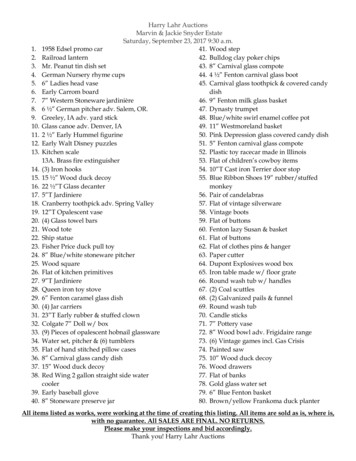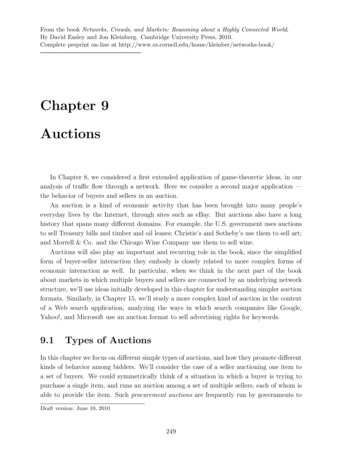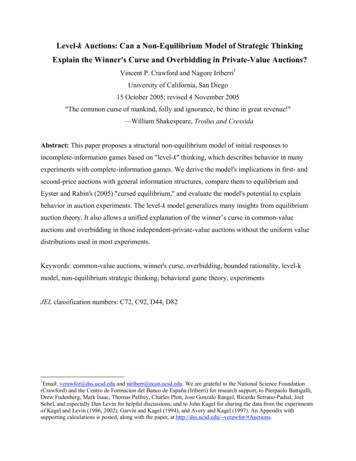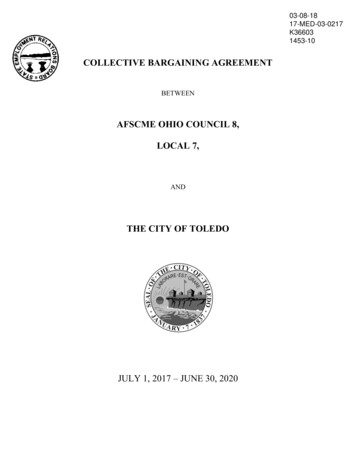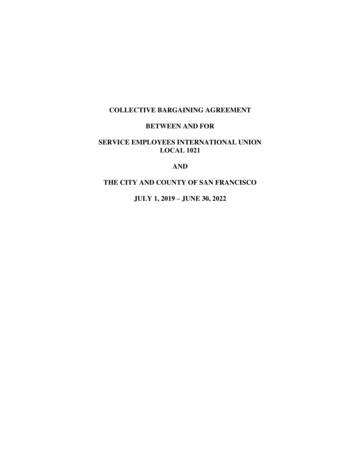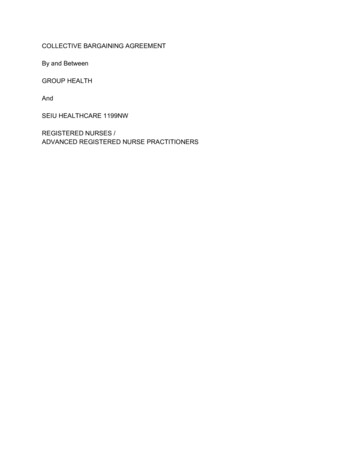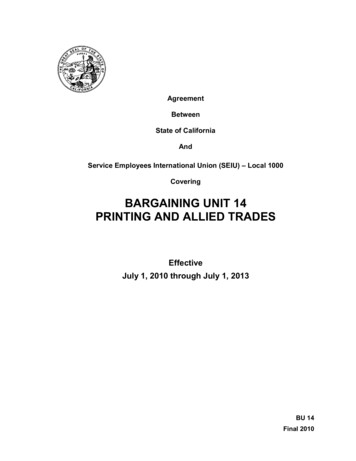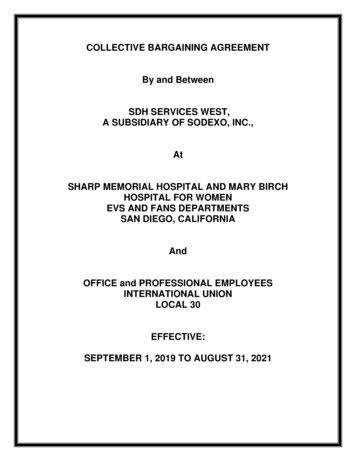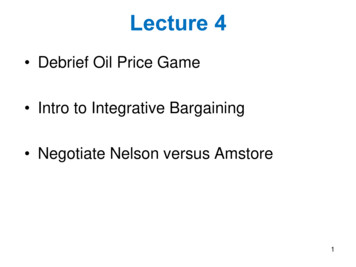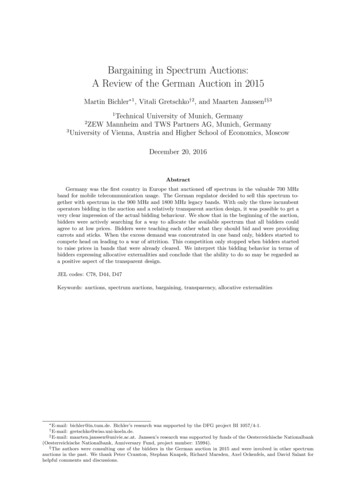
Transcription
Bargaining in Spectrum Auctions:A Review of the German Auction in 2015Martin Bichler 1 , Vitali Gretschko†2 , and Maarten Janssen‡§31Technical University of Munich, GermanyZEW Mannheim and TWS Partners AG, Munich, Germany3University of Vienna, Austria and Higher School of Economics, Moscow2December 20, 2016AbstractGermany was the first country in Europe that auctioned off spectrum in the valuable 700 MHzband for mobile telecommunication usage. The German regulator decided to sell this spectrum together with spectrum in the 900 MHz and 1800 MHz legacy bands. With only the three incumbentoperators bidding in the auction and a relatively transparent auction design, it was possible to get avery clear impression of the actual bidding behaviour. We show that in the beginning of the auction,bidders were actively searching for a way to allocate the available spectrum that all bidders couldagree to at low prices. Bidders were teaching each other what they should bid and were providingcarrots and sticks. When the excess demand was concentrated in one band only, bidders started tocompete head on leading to a war of attrition. This competition only stopped when bidders startedto raise prices in bands that were already cleared. We interpret this bidding behavior in terms ofbidders expressing allocative externalities and conclude that the ability to do so may be regarded asa positive aspect of the transparent design.JEL codes: C78, D44, D47Keywords: auctions, spectrum auctions, bargaining, transparency, allocative externalities E-mail:bichler@in.tum.de. Bichler’s research was supported by the DFG project BI 1057/4-1.gretschko@wiso.uni-koeln.de.‡ E-mail: maarten.janssen@univie.ac.at. Janssen’s research was supported by funds of the Oesterreichische Nationalbank(Oesterreichische Nationalbank, Anniversary Fund, project number: 15994).§ The authors were consulting one of the bidders in the German auction in 2015 and were involved in other spectrumauctions in the past. We thank Peter Cramton, Stephan Knapek, Richard Marsden, Axel Ockenfels, and David Salant forhelpful comments and discussions.† E-mail:
1IntroductionEconomists have long argued that auctions will promote efficiency when governments award spectrumlicenses to private companies (Coase, 1959).1 Theoretical research on the properties of auctions playeda key role and provided central arguments for the use of auctions for spectrum sales.2 To understandwhether or not auctions in general, and specific auction designs in particular, have lived up to thisexpectation of promoting efficient allocations, we should not only understand the theoretical propertiesof these auction designs, but especially see how bidders behave in particular auctions in the field. Ifbidders actually behave quite differently from what the theoretical model assumes, the value of theoreticalpredictions concerning auction properties is limited.In this paper, we analyze bidder behaviour in the recent 2015 German auction in detail. One advantageof studying bidding behaviour in the German auction is that the regulator made the highest standingbids after each round publicly available. Bidders even learned about all bids submitted after each round.This allows us to use publicly available data to analyze actual bidding behavior in detail. We show thatsimple straightforward bidding does not explain bidder behaviour. Our analysis identifies different kindsof deviations from straightforward bidding and we rationalize these deviations with economic argumentsand a simple model.The German auction used the SMRA format.3 If the blocks are substitutes for each other and biddersbid straightforwardly in each round, then the SMRA terminates in a Walrasian equilibrium (Milgrom,2000). Gul and Stacchetti (1999) showed that even if the substitutes condition is satisfied, then ascendingand linear-price auctions such as the SMRA cannot implement the VCG outcome. In contrast, demandreduction has widely been observed in the field and analyzed game-theoretically (Ausubel et al., 2014).The SMRA is a family of auction rules, where the common feature is a multi-object version of the Englishauction: bidders express bids in increasing fashion, the auctions stops when no bidder expresses new bidsand winning bidders pay their last own bid(s). SMRAs differ along many dimensions, but an importantdifferentiation is the level of transparency after each auction round. In many countries, bidders in anSMRA only learn the minimum bid price for a license in a new round, but they do not learn what otherbidders are winning or even what they have bid on in the last rounds. The SMRA implementation usedin Germany is different in this respect. Bidders learn the entire bid history of other bidders from thestart.Our description of bidding behaviour in the 2015 auction and the simple game theoretic explanations1 Thefirst implementation had to wait until 1994 when the US Federal Communications Commission (FCC) used thesimultaneous multi-round auction (SMRA) for the sale of radio spectrum for personal communication services (PCS). See,Porter and Smith (2006) for a historical overview that finally led to this auction.2 For example,Milgrom (2000) writes that ”the auction design made detailed use of the ideas of economic theory and therecommendations of economic theorists.”3 Theoretically, equilibrium bidding strategies are not easy to derive for an SMRA. A full Bayesian analysis for generalvaluations is quite challenging (Goeree and Lien, 2014) and theoretical models need to make restrictive assumptions, whichdo not always carry over to the field.1
of different behaviours suggest that bargaining about the full allocation serves as an adequate descriptionof bidding behaviour. In an initial cooperation phase, bidders try to implicitly coordinate on an allocationat low cost. If bidders cannot agree on a focal point they bargain about different allocations with costlysignals in a competition phase. The bidding behaviour indicates that bidders care about the full allocationand not only about the share of the spectrum supply they themselves acquire. They do so by indicatingto others (”teaching others”) that they should reduce their spectrum demand. Whether the spectrum isequally distributed among the operators in a market or whether there is a dominant player who owns alarge share has a substantial impact on the competition in the downstream market. So, it is not surprisingthat the relative size of a bidder’s package compared to that of the other bidders matters.Our paper not only provides new insights into how bidders bid in real-world auctions. It also adds anew perspective on questions regarding auction design. As we have indicated above, and we will showin more detail in the main body of the paper, the transparent auction design of the German auction(s)allows bidders to express their preferences over the full allocation. Some papers have argued that there istoo much transparency in these auctions, as it enables bidders to implicitly coordinate their behaviour ona low-revenue outcome (cf., Grimm et al. (2003) and Cramton and Ockenfels (2016)). Although, we agreewith this argument (and we show there are clearly some elements of this present in the 2015 Germanauction), we also think that a transparent design has certain advantages in the presence of significantallocative externalities. If bidders do not learn during the auction how the spectrum is divided amongall players they face a substantial strategic problem. In an intransparent auction a bidder might expectthe final allocation to be fairly balanced. If, however, one strong player emerges instead, who winsmost of the complementary licenses, then the net present value for his package would be much lower,because end consumers will often decide to switch to the operator with the best network, i.e., the onewith most spectrum. Transparency may help bidders to express these allocative externalities as they canveto undesirable allocations with their bids. One insight we provide is that there is a trade-off whendeciding on the level of transparency in an auction. On one hand, allowing for some transparency enablesbidders to express their allocative externalities in a simple way. On the other hand, allowing for too muchtransparency may facilitate implicit coordination among bidders. However, such implicit coordinationwould hardly lead to an asymmetric allocation of spectrum with a dominant player. Since regulators aimfor a sustainable competition in the end consumer market, transparency might actually be positive inmarkets where allocative externalities matter.Allocative externalities are particularly important in national markets with only a few competitors(which is what we have in most countries worldwide), and considering these externalities sheds a differentlight on the question how efficient auction markets should be designed. Thus, this paper points suggeststaking allocative externalities more serious in the spectrum auction design literature.44 There is some literature on the fact that bidders’ bidding behaviour is affected if allocative externalities play a role (see,e.g., Jehiel and Moldovanu (2000); Goeree (2003); Jehiel et al. (1996); Janssen and Karamychev (2009, 2010); Klemperer2
Due to its high level of transparency, the German auction design is specific and one may wonderwhat one can learn from studying this auction for other markets. We argue that the German auction isnot only interesting in its own right, but that it is also interesting for other markets for several reasons.First, the high level of transparency makes it possible to observe behaviours that bidders would like toundertake in less transparent auctions, and that outside observers may not be able to disentangle dueto the intransparency. In particular, in small markets with only a few bidders, competitors may oftenbe able to guess what the other bidders bid based on prior knowledge even with less information aboutthe bidders’ bids in each round. Second, and more importantly, the fact that bidders have preferencesover the full auction allocation is independent of the auction format. The findings from the Germanauction are probably relevant for many other spectrum auction markets, as allocative externalities andthe relative spectrum allocation of telecoms almost always play a role.Third, regulators and mobile companies often treat relative auction prices across different spectrumbands in important auctions as reflecting the relative value of spectrum in the different bands. The 2015German auction is no exception. For example, in a recent decision (September 2015) on so-called annuallicense fees, the British regulator Ofcom used relative auction prices in various auctions, including the 2015German auction as indicators for the market value of spectrum licenses in the UK. We argue that pricesin different bands in the 2015 German auction can largely be explained by specific bidding strategies andthey reveal little about the underlying valuations that operators may have for these spectrum licenses.Due to the high degree of transparancy in the bidding process, this paper is able to establish this for theGerman auction, but a similar conclusion is likely to hold for other auctions as well.There are a number of papers with descriptions of European spectrum auctions around the year 2000(Illing, 2005; Klemperer, 2002). Two papers have a similar flavour to ours, also analyzing individual bidderbehavior in detail. Börgers and Dustmann (2005) analyze bidding behaviour in the 2000 UK auction andshow that the bidding behaviour of several companies significantly deviated from straightforward bidding.They mention several possible reasons for these deviations. An important difference between their paperand ours is that the auction designs have significantly progressed since 2000. In the 2000 UK auctionand in many 3G auctions that were held around that time in Europe (except Austria and Germany), thecombinations of licenses were determined ex ante by the regulator and each mobile operator could winat most one such combination. Since then it has become more common to design the allocation processsuch that multiple units are for sale and mobile operators can combine their own packages. This allowscompanies to develop more sophisticated bargaining strategies where bidders can signal how they thinkthe available supply should be allocated.Cramton and Ockenfels (2016) perform a similar analysis to ours for the 2010 German auction. Thestrategic situation in the 2015 auction differed, however, substantially from the 2010 auction. In the(2002). However, when it comes to auction design, the traditional assumption that bidders only value their own share andnot the full allocation is predominant.3
2010 auction, there was one bidder (EPlus) that could drive up the prices of competitors at little cost forhimself, because it was possible for EPlus to drop out of the most valuable 800 MHz band and become alow-cost operator with a lower quality network. The possibility for EPlus to act as if it was a strong bidderbidding for 800 MHz band blocks at relatively high prices (similar to a pooling strategy in a signalinggame), was an important consideration in the 2010 auction. In this 2010 auction, even a weak EPluscould pretend to be a strong bidder to raise rivals’ cost. Raising rivals’ costs is a wide-spread strategyin auctions where bidders meet again in the downstream market, as it weakens competitors and bindstheir budgets in the downstream market. In contrast, in the 2015 auction all bidders needed spectrumin all bands and price driving strategies always implied a cost increase for the bidder himself.5 As wewill argue, the resulting strategic situation in the 2015 auction resembles that of a war-of-attrition game.Another important difference between the two auctions is that with three bidders, one can deduce muchbetter the actual bidding behaviour from the publicly available bid data. This allows us to go into moredetail concerning actual bid strategies that bidders followed than Cramton and Ockenfels (2016).The rest of the paper is organized as follows. Section 2 describes the market environment of theGerman mobile telephony sector at the time of the 2015 auction and the auction rules in detail. Section3 provides an in-depth overview of the bidding behaviour in the auction. Section 4 provides an extensiveinterpretation of that behaviour in terms of game theoretic bidding strategies. To answer the questionwhat is specific about the 2015 German auction, Section 5 compares this auction to other SMRAs. Section6 concludes with a discussion on auction design issues.2Auction Rules and Market EnvironmentTo understand the strategic possibilities of the bidders in this auction it is important to first discuss therelevant competitors, the market environment and the spectrum that was for sale.Shortly before the auction the third largest Mobile Network Operator (MNO) in the market, Telefonica, merged with the former fourth largest MNO, EPlus. As a consequence, there were three active MNOsin the German market before the auction: Telekom Deutschland (DT), Vodafone (VOD), and Telefonica(TEF). These were also the only three bidders in the auction: no new competitors were admitted to theauction. Before the start of the auction DT was the market leader in terms of service revenues, followedby VOD and TEF. Moreover, according to Connect, a magazine testing the mobile network quality inGermany every year, DT had also the highest quality network.6 In terms of number of customers, TEFwas the market leader followed by DT and VOD (after the merger between TEF and EPlus). The differences between the three players were not very large, however. The overview of the market is depicted inFigure 1.75 Withthe exception that TEF did not want to acquire licenses in the ancillary downlink only 1500 MHz 4431.html.7 The numbers are taken from the publicly available yearly financial reports of the respective companies.6 See4
Figure 1: Market shares of the involved bidders in terms of service revenues and number of subscribersat the end of fone28%25%20%15%10%05%00%Service revenuesSubscribersThe spectrum holdings of each operator prior to the auction are depicted in Figure 2. Due to themerger, TEF had the largest spectrum holdings. It is important to note, however, that as part of themerger remedies, the German regulator BNetzA reserved the right to reallocate some of the TEF ownedspectrum, especially in the 2.1 GHz band, after observing the results of the auction. Thus, the auctionwas conducted under a high degree of uncertainty for all bidders whether, and if so how, the allocationof spectrum in the Germany would be reorganized after the auction (and maybe as a consequence of theoutcome of the auction).BNetzA offered spectrum for mobile use in four different bands to be auctioned in the 2015 auction:700, 900, 1800, and 1500 MHz. The spectrum in the 700, 900, and 1800 MHz band was offered in 2x5MHz paired blocks (FDD spectrum), whereas the spectrum in the 1500 MHz band was offered in 1x5MHz downlink only blocks (DL spectrum). Some of the blocks were specific. That is, the winner of aspecific block wins that specific frequency block. The rest of the blocks was generic. In what follows wegive a brief description of important characteristics of each band. 700 MHz: The 6 blocks were previously used for television broadcasting and were divided into onespecific block and 5 generic blocks. The specific block was less valuable, i.e., debased, because itcame with special obligations. The block could only be used if additional investments are made bythe winner of this block. Spectrum in the 700 MHz band is most likely to be used for the new LTE(Long Term Evolution, 4G) technology. 900 MHz: The 7 blocks were already in use by the bidders for GSM (2G) and were divided intoone specific block and 6 generic blocks. The specific block is debased in that it faces interferencewith the GSM network of the German railroad (GSM-R). Using this block for LTE would require5
additional investments. Each bidder was only allowed to purchase up to 3 blocks of 900 MHzspectrum (spectrum cap) to ensure that each operator at least receives one block of spectrum toseamlessly continue their operation. If a bidder would acquire 3 blocks of 900 MHz spectrum, hewould have the possibility to use two blocks for LTE, otherwise he would likely continue to use allof his 900 MHz spectrum for GSM. Thus, for any of the bidders acquiring three blocks of 900 MHzis most likely to have a large incremental value compared to acquiring two blocks. 1800 MHz: Of the 10 blocks for sale, 9 were already in use by the bidders for mobile services, whileone block was the guard band to secure not to have interferences between the mobile services andthe cordless DECT telephones. This block was specific, while the rest of the blocks were generic.The specific block is debased in that it may face interference with cordless phones, leading againto additional investments being needed from the winner of this block to use this block effectively.Importantly, in addition to the spectrum for sale at auction, DT was holding 3 blocks and TEF 2blocks in the 1800 MHz band. These MNOs acquired this spectrum in the 2010 spectrum auction.If the spectrum in the 1800 MHz band is used for LTE technology, then it is most valuable ifafter the auction the bidder can either assemble 4 or 6 adjacent blocks. In particular, acquiringa 5th block of 1800 MHz spectrum has a relatively small intrinsic incremental value (apart frompreventing another MNO to acquire a 4 or 6 adjacent blocks). This spectrum could also be used,however, for GSM technologies and some of the operators probably intended to use some of theirspectrum in this band for GSM. For GSM usage, any block of 2x5 MHz is valuable.8 1500 MHz: The 8 blocks that were for sale in this band were previously used for radio broadcasting.All blocks were auctioned as generic blocks. This band was considered to be a non-mainstreamband, inferior to existing bands. Moreover, at the time of the auction there were no mobile devicesavailable that would make use of the 1500 MHz band.The regulator implemented a simultaneous multiround auction (SMRA) using the same rules thatwere used in the 2010 German spectrum auction. Most of the rules are standard9 and include an activityrule, click-box bidding, waivers, minimum increments etc.10 . The staged activity rule requires bidders tobid actively from the start. Bidders had activity points, and if they did not bid on a certain percentageof these points in each round or win a certain number of licenses, they lost activity points. In principle,BNetzA could increase the activity requirement in three stages, where in the last stage, any reduction ofdemand would imply a loss in activity points. Bidders could then bid on less licenses. In earlier stages8 At the time of the auction DT was the only operator that was not running any other services besides LTE on the 1800MHz band. Thus, for VOD and TEF who were using 1800 MHz for GSM it is of some value to hold more than 4 blocksof 1800 MHz spectrum after the auction to have some maneuvering room when shifting customers from 1800 MHz GSM toother bands. In particular, due to the E-Plus merger TEF was using 2x25 MHz in the 1800 MHz band for GSM services.Thus, if TEF would acquire merely 2 blocks of 1800 MHz spectrum it would not be able to use their current holdings of2 blocks in the 1800 MHz band to assemble 4 adjacent blocks of 1800 MHz spectrum for LTE in the first couple of yearsfollowing the auction.9 For a general description of SMRAs see Cramton (2006).10 The rules of the auction can be found at www.bundesnetzagentur.de.6
Figure 2: Allocation of spectrum before the ,020,015,010,05,0700 MHz 900 MHz 1500(FDD)(FDD) MHz (DL)1800MHz(FDD)800 MHz(FDD)Bands in the (TDD)Bands not in the auctionwith lower activity requirements, bidders can still increase demand to some extent, in spite of a demandreduction in an earlier round. Throughout most of the auction the activity rule was set at 65%. A bidderkeeps his bid rights for the subsequent auction round, if he satisfies this minimum activity level. Toactually loose activity points bidders had to express demand that is below 65% of their current level ofactivity points.An important specific feature of the German auction format is that in each band the blocks werenamed alphabetically11 and even if the blocks were generic, bidders had to bid on blocks with specificletters rather than just specify the quantity demanded of the generic blocks: if a bidder wanted toacquire more spectrum then they are holding at the end of a certain auction round, they had to overbidother bidders on specific spectrum blocks. For example, a bidder demanding 2 generic blocks in the 700MHz band had to place specific bids on specific blocks (for example, the B and D block). Moreover, inevery round and for each block the identity of the highest standing bidder and his bid was made publicand bidders were informed about the total demand of each of the bidders in every band. That is, theinformation received by the bidders differed from the information made available to the public in onerespect: bidders were able to see not only the highest bid on a particular block but also all unsuccessfulbids for this block. An example for the publicly available data can be found in Figure 3.12 This kind oftransparency is what distinguishes the German auction from other SMRAs.13This high degree of transparency allows the bidders to use bids to communicate with their competitors.11 Forexample, in the 900 MHz band the blocks were named from A to G.though we will argue below that transparency can be beneficial for efficiency, there seems to be no reason at allto provide bidders and the public with different amounts of information.13 See also (Cramton and Ockenfels, 2016) in their analysis of the 2010 German spectrum auction.12 Even7
Figure 3: Example for publicly available bid data from round 11.This kind of communication is facilitated by the relaxed activity rule of 65%.3A Description of the Bidding BehaviourIn this section we will describe the main developments in the auction in terms of three phases: an initialcooperation phase, followed by a lengthy competition phase and a short end phase. In the cooperationphase, the demands of the bidders reflect a search for a mutually compatible set of bids that are consideredappropriate for each of the three bidders individually. At the end of the cooperation phase it becameclear that there is no allocation that is acceptable for all bidders without a fierce price war. Thus, thecooperation phase is followed by a competition phase where bidders fight for one or more blocks to achievea certain allocation. The competition phase ends when prices rise to a sufficiently high level that oneor more bidders reduce their demand. The 2015 auction ran over the course of 4 weeks or 181 rounds.Auction revenues totaled over EUR 5 billion.14In what follows we will use a 3-tuple as a short hand describing how many licenses a bidder demandedin his bid in the 700 MHz, 900 MHz, and 1800 MHz band. For most of the time we will thereby ignorethe 1500 MHz band which was less valuable and not decisive for the strategic situation. Whenever weexplicitly consider demand in the 1500 MHz band we will denote demand as a 4-tuple. For example, ifDT was bidding on 2 licenses in the 700 MHz band, 3 licenses in 900 MHz band, and 3 licenses in the14 Detailedinformation on the bidding and outcome of the auction can be found at www.bundesnetzagentur.de8
1800 MHz band, we will denote this by 2-3-3, if we want to point out that DT was also bidding on 4licenses in the 1500 MHz band, we will denote this by 2-3-3-4.3.1The Cooperation Phase (Rounds 1-30)(i) Opening bids(rounds 1 to 6). The first bid (together with the bids in the first couple of rounds)revealed that TEF bids for 2-2-5 including the specific blocks in the 700 MHz and the 900 MHzband. Given it could keep two blocks in the 1800 MHz band, this could be considered a relativelyaggressive bid in the 1800 MHz band, but TEF compensated this by immediately bidding on thedebased blocks in both the 700 and 900 MHz bands, even though the starting prices probably didnot fully reflect the value of the restriction.15 VOD and DT demanded 2-3-4. The overall excessdemand amounted to 0-1-3. Remarkable was the position of VOD’s bids in the 900 MHz band andTEF’s bids in the 1800 MHz band in the first round.16 In the 900 MHz band VOD bid on blocksD to F leaving open blocks A to C and block G. In the 1800 MHz Band TEF bid on block B to Fleaving open block A and blocks F to J. One way to interpret such bids is that VOD was offeringto divide the 900 MHz band in a way such that one bidder receives 1 block of 900 MHz spectrumand two bidders receive 3 blocks each. In the 1800 MHz band the bids of TEF can be interpretedas an offer to divide the 1800 MHz band in a way that one of the bidders receives 1 block, oneof the bidders receives 4 blocks and TEF receives 5 blocks.17 After the opening bid, the bidderscontinued in the first 6 rounds by bidding on the cheapest undebased blocks without changing theoverall demand.(ii) Establishing the claims (rounds 7 to 18). In the rounds following the opening bids, the bidders didnot change their demands. However, in contrast to the opening rounds, bidders sometimes did notbid on the cheapest undebased blocks after they were outbid on one of their blocks. Bidders weremaking sure that their competitors understand their demand and the potential overall allocations.For example, at the end of round 6, VOD was the highest standing bidder on only 2 blocks in the900 MHz and needed to bid on a third block. However, In round 7, TEF raised the bid on one of theblocks in the 900 MHz band for which they were already the highest standing bidder after round 6.This prevented VOD from outbidding TEF on this particular block in round 7.18 In round 13, TEFoutbid VOD instead of DT who was holding the cheapest block in the 900 MHz band after round13, probably intending to indicate that TEF thought that VOD had to reduce demand in the 900MHz band to avoid price increases.15 Moreover,TEF was not bidding in the 1500 MHz band.publicly available bid data only allows to deduce the demands of VOD and TEF in those bands with certainty asbids on some of the blocks are not shown if another bidder bid earlier or higher on one of those blocks.17 Given the spectrum holdings in the 1800 MHz band that DT and TEF hold outside the auction, this would imply thatboth DT and VOD were offered a total of 4 blocks each.18 Even though VOD’s bid is not visible in the publicly available data it is highly likely that it was bidding on thisparticular block in round 7.16 The9
(iii) Demand reductions (round 19 to 30). In round 19, it appears that DT reduced their initial demandof 2-3-4 to 2-3-3. DT placed jump bids on the 3 blocks in the 900 MHz band and on the 3 blocksin the 1800 MHz band for which they were the highest standing bidder after round 18. Thus, DTincreased prices on blocks it already ”owned”.TEF followed in round 21 by reducing its initial demand of 2-2-5 to 2-2-4. However, in the sameround, instead of bidding on the cheapest undebased blocks it outbid DT on one of its blocks, whichdue to the jump bid from round 19, was one of the significantly more expensive blocks. At thispoint the overall excess demand was reduced to 0-1-1.In rounds 22 to 29 the overall demand of the bidders did not change. TEF and VOD were consistentlyoverbidding each other in the 90
Bargaining in Spectrum Auctions: A Review of the German Auction in 2015 Martin Bichler 1, Vitali Gretschkoy2, and Maarten Janssenzx3 1Technical University of Munich, Germany 2ZEW Mannheim and TWS Partners AG, Munich, Germany 3University of Vienna, Austria and Higher School of Economics, Moscow De
